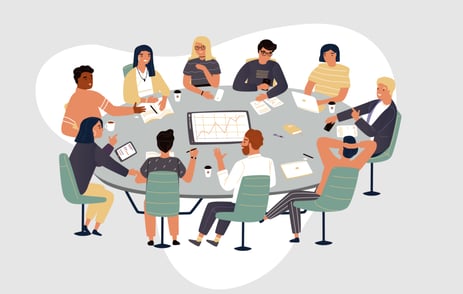Whether your organization is entirely volunteer-led or you have volunteers at the helm of integral committees and programs, there’s no secret that these folks are often the backbone of associations and nonprofits.
And while volunteer management is top of mind for many leaders, addressing your pipeline is just as important. Volunteer recruitment takes intentionality, but it also takes awareness – particularly when you’re looking to build an inclusive culture.
Focusing on creating accessible volunteer opportunities is key – and here’s what associations need to know to get it done.
Understanding Accessibility Concerns
Accessibility in the context of volunteering refers to the ease with which members with diverse abilities, backgrounds and needs can participate in and benefit from volunteer opportunities. For associations, that means considering aspects like physical accessibility, communication and inclusion when creating and staffing these roles.
However, accessibility isn’t limited to physical or cognitive concerns. When it comes to your volunteering roles, factors like cultural differences and customs, language barriers, socioeconomic concerns and basic availability can all stand in the way of your members getting involved.
This creates a more inclusive culture and, on an organizational level, helps put talented and passionate volunteers in positions to move your association's mission forward.
Exploring Volunteer Accessibility Roadblocks
One of the biggest problems with addressing accessibility in volunteering is understanding where those roadblocks are. For associations and nonprofits, this can include:
- Limited awareness: One of the more common (and easy to address) issues with volunteer roles is awareness. Your members won’t feel comfortable applying for roles if they aren’t sure if they’ll be able to fulfill the responsibilities. From responsibilities and accommodations to inclusive language and imagery in your materials – awareness is essential.
- Inaccessible facilities: Lack of ramps, elevators, or wide doorways can make it difficult for people with mobility impairments to access volunteer locations. Not only should you ensure facilities are accessible, but also take the time to put that information in your description – people want to feel confident they can serve without limitations.
- Insufficient accommodations: A lack of reasonable accommodations, such as assistive technology or alternate formats for materials, can create barriers for people with disabilities who wish to volunteer.
- Communication barriers: The absence of accessible communication methods, such as sign language interpreters or captioning, can exclude people with hearing impairments from volunteering. Similarly, for associations working in culturally diverse areas, don’t forget the need for translation.
- Financial barriers: While volunteering can be rewarding, that doesn't mean it's financially feasible for all. Do not ignore the socio-economic impact of your volunteering roles. Associated costs like transportation, food, childcare and work commitments can all prevent people from volunteering.
- Virtual accessibility: With the rise of remote and virtual volunteering opportunities, a lack of accessible online platforms or digital materials can prevent people with disabilities from engaging in these roles. Instituting or expanding a virtual volunteer program can be a quick and effective win for any organization.
Why Should Associations Be Worried?
For associations, volunteer recruitment and management can be their own challenge, which is often why accessibility moves to the back burner. However, addressing these barriers to participation can have major benefits.
For starters, diverse volunteers help organizations harness different perspectives, backgrounds, experiences and abilities.
This not only assists in addressing the challenges volunteers encounter but also provides a fresh perspective on the obstacles and drawbacks your members potentially face.
Similarly, when we make our volunteering opportunities accessible, we promote social inclusion and community engagement, helping break down barriers and fostering understanding among people with different abilities. At the same time, it also creates opportunities for members to grow their skills and make connections, a key reason they joinyour association in the first place.
Finally, and often most importantly, by making your volunteer opportunities accessible to all, you can tap into a much larger pool of invaluable candidates that weren't able or aware of their opportunities to serve.
8 Strategies for Addressing Volunteer Accessibility
As we mentioned before, creating accessible volunteering opportunities takes intentionality. For associations looking to move the needle, some strategies to consider include:
- Develop an accessibility policy: Create a clear and comprehensive policy outlining your association's commitment to inclusivity and accessibility in volunteering. This policy should be easily accessible and communicated to all staff, volunteers and potential volunteers.
- Adopt inclusive language and imagery: Ensure that all promotional materials, including website content, brochures and social media posts, use inclusive language and highlight diverse volunteers, including those with disabilities.
- Offer flexible volunteer opportunities: As we mentioned, not everyone can drop everything and volunteer. From flexible scheduling to remote or virtual volunteering opportunities, creating flexibility can help get more people involved.
- Provide accommodations and support: Offer reasonable accommodations for volunteers with disabilities, such as assistive technology, sign language interpreters or modified workspaces. Be proactive in identifying and addressing potential barriers and audit your own facilities to ensure they're accessible to all. This may include installing ramps, widening doorways, or providing accessible restrooms.
- Partner with disability organizations: Collaborate with local disability organizations to gain insights into accessibility needs, receive guidance on creating more inclusive volunteer opportunities and connect with new members and communities that can help move your organization forward.
- Train staff and volunteers on accessibility: Provide disability awareness and sensitivity training for staff and volunteers to foster a supportive and inclusive environment. Ensure that everyone understands their role in promoting accessibility.
- Establish an accessibility feedback system: Encourage volunteers to provide feedback on their experiences and any accessibility issues they encounter. The more you know, the more easily you can adjust and elevate your volunteer program.
- Celebrate diversity and inclusion: Showcase the successes and achievements of volunteers with disabilities and recognize the valuable contributions they make to the organization. Remember, your mission is to empower others – and volunteers are often the first contact point for your organization.
Empowering Your Members & Communities
As associations, empowering others is a part of your mission. And when it comes to volunteers – a critical role in all organizations – ensuring your opportunities are accessible to all is key. For starters, associations should spend time understanding the challenges facing specific roles. Whether it’s physical barriers, language difficulties or a lack of flexibility and availability, understanding these concerns can help you adjust and accommodate.
From there, it’s a matter of adding new strategies to your volunteer management. Focusing on adding inclusive language and imagery, creating new volunteer roles with added flexibility and remote opportunities, and even partnering with accessibility-focused organizations are a few of the ways your association can create accessible volunteering opportunities.

April 13, 2023


